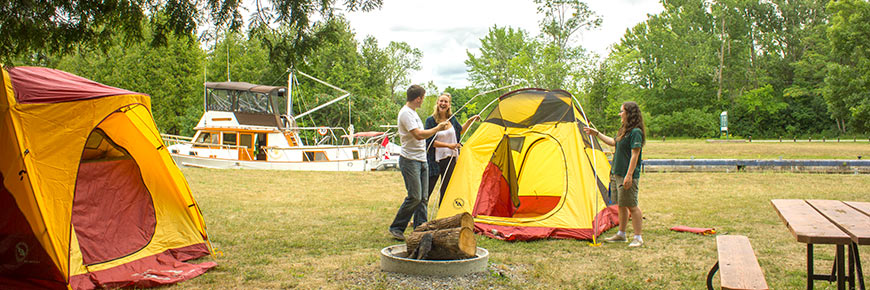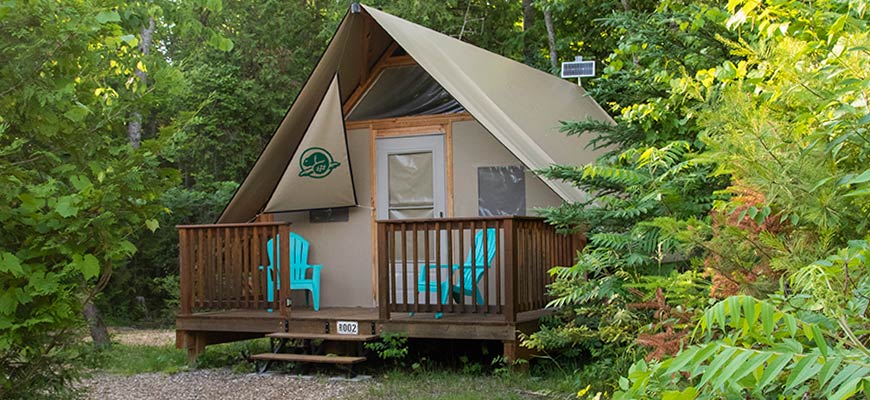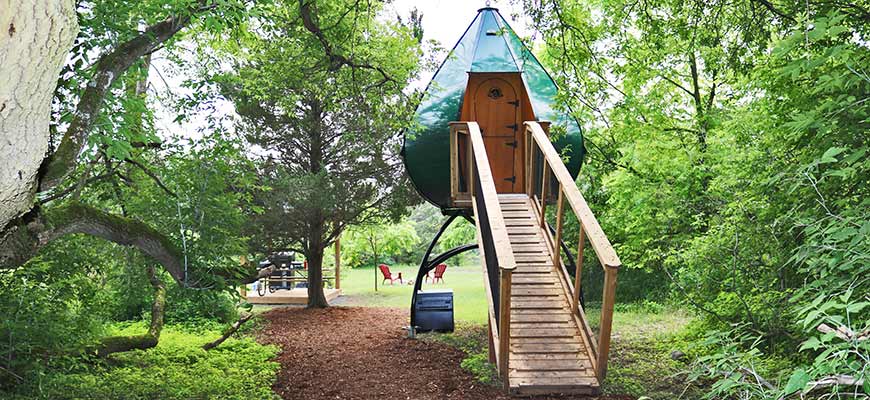
Camping at lockstations
Trent-Severn Waterway National Historic Site
Sleep in your tent alongside the waterway and enjoy a night in the great outdoors. Camping is a fun and affordable way to get off the boat for the evening and immerse yourself in the daily activities at the lock. Paddlers and cyclists will find the sites make great places to start or end a trip, and perfect overnight stops along any route.
Know before you go
Where can I camp along on the Waterway?
No car camping
First-come, first-served tent camping is only available to visitors arriving by boat (paddlers or vessels under power), and those who hike/cycle to the lockstation. Drive-up car camping is not permitted at the lockstation. Reservable campsites on the Trent-Severn Waterway do allow drive-up campingLockstations with camping:
Tent camping is allowed at most lockstations on the Trent-Severn Waterway at the discretion of the lockmaster on duty. Sites are typically located in grassy areas around the lockstation and adjacent the waterway's mooring walls and/or paddle docks.
Lockstations without camping:
Camping is currently not available at the following lockstations due to a lack of public space and facilities:
- Hastings (Lock 18)
- Scotts Mills (Lock 19)
- Peterborough Lift Lock (Lock 21)
- Young's Point (Lock 27)
Large groups
Most campsites can not be reserved and available space on any given day is not guaranteed. Large organized cycling and hiking groups (6+) should communicate their camping plans to Parks Canada in advance of their visit, to better prepare for their arrival. Please email:
Other camping
Camping options exist all along the waterway, in provincial parks, populated communities, and privately-owned sites. Check with the local tourism experts in your region to learn about other options not found at lockstations.
How much does it cost?
Camping permits and fees may vary; depending on the availability of services at each lock. Check our Fees page for current camping costs and other related fee information for visitors.
Boaters who pay for overnight mooring are welcome to camp on land free of charge (1 tent).
When does camping open for the season?
Camping at lockstations is available annually from mid-May to early-October during the Navigation season.
Hours of OperationHow do I reserve a campsite?
Non-reservable campsites:
Camping at lockstations works a bit differently than camping at other Parks Canada places. Most campsites on the Trent-Severn Waterway are first-come first-served. Available space on any given day is at the discretion of the lockmaster on duty.
Phone ahead!
The best way to secure a campsite, or check the availability before you visit, is to phone the lockstation directly and notify them of your plans. Contact a lockstation during operating hours to speak to lock staff about availability.
Reservable campsites:
There are some reservable tenting sites along the Trent-Severn Waterway which can be booked online or by phone:National Reservation Service
Phone number: 1-877-RESERVE (737-3783)What facilities are available at the lockstation?
Service levels throughout the season are subject to change without notice. It's important that you phone ahead for the most up-to-date information.
At the lockstation:
- Accessible washrooms
- Garbage and recycling
- Firepits with cooking grill
- Picnic tables
- Maps and other visitor information
Other amenities:
Select locksations may also offer showers, firewood and ice. Contact a lockstation directly to inquire.
Many lockstations are also located in the middle of a waterfront community. At these locks, restaurants, grocery stores, outfitters and entertainment are often only a short walk from your campsite.
When you get here
Checking in
- Staff hours:
-
- Lock Staff are on site as per the Trent-Severn Waterway National Historic Site Hours of Operation seasonal schedule, and will be prepared for anticipated arrivals between 1:00 pm and 4:00 pm
- Check-in time:
-
- After 3:00 pm
- Check-out time:
-
- Before 11:00 am
- After hours registration:
-
- If you plan on arriving outside of staffed hours, please call the lockstations directly to obtain check-in instructions ahead of time.
Accessing your site
- Mooring:
-
- Boaters can safely moor their vessels at the lockstation overnight while they camp
- An overnight mooring permit is required for your vessel; camping fees will be waived
- Mooring permits may be purchased on-site or online in advance
- A short walk from the mooring walls may be required to reach your campsite
- Walking and cycling:
-
- Your campsite may be located in an area of the lockstation that could be challenging to reach on foot
- In some cases, you may be required to cross the lock gates on a narrow overhead walkway
- Bicycles may not be able to cross some overhead walkways
- Visitors should be physically prepared to carry their gear and equipment short distances to reach their site
- Phone the lockstation in advance to inquire about specific site access limitations
Visitor Guidelines
- Quiet hours:
-
- 10:00 pm to 7:00 am
- Maximum camping units per site:
-
- 2 Tents
- Maximum persons per site:
-
- Up to 6 people
- Generator policy:
-
- Use of any generator is limited to 7:00 am - 10:00 pm
- Electrical service:
-
- None
- Fires
-
- Fires are only allowed in designated fire rings
- Random fires are not allowed on National Historic Sites
- Charcoal barbecues and propane fire rings are permitted
Please keep your campfire safe for you and the environment by following these rules:
- Keep fires small
- Never leave a fire unattended
- Dump cold BBQ ashes into a fire pit
Firewood
Firewood can not be brought into the historic site. Transporting wood from elsewhere may spread invasive insects and disease. Firewood must be purchased within the site and is available at the lockstation for purchase during operating hours. You must call the lockstation in advance if you are arriving outside of operating hours. Do not burn garbage or collect deadfall from the surrounding forest for burning.
Protect your forests from the Emerald Ash Borer
The Emerald Ash Borer is a highly destructive invasive insect which attacks and kills all species of ash. It has the capability to spread rapidly throughout trees and forests. A single piece of infected firewood can be detrimental to thousands of trees and forests.
- Garbage and litter
-
- Garbage and recycling bins are located at all lockstations on the Trent-Severn Waterway. Please use them to dispose of your waste.
- Good times in the great outdoors are safer and more rewarding when you Leave No Trace of your visit
Related links
- Date modified :

